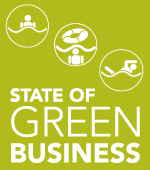Applying Radical Transparency to Your Paper's Carbon Trail
<p>New Leaf Paper and Office Depot will soon take consumers on a virtual carbon trail of New Leaf's 100 percent recycled paper in hopes of encouraging them to think and act sustainably.</p>

New Leaf Paper and Office Depot will soon take consumers on a virtual carbon trail of New Leaf's 100 percent recycled paper in hopes of encouraging them to think and act sustainably.
At last Thursday's State of Green Business Forum in Chicago, Jeff Mendelsohn, founder and CEO of San Francisco-based New Leaf Paper, and Yalmaz Siddiqui, director of environmental strategy at Office Depot, told attendees they are in the process of developing web-based technology that will allow consumers to scan a quick response code with their smart phone on each New Leaf Paper package. After scanning the tag, consumers will be told the story of where their paper came from.
The web video will be specific to each customer's purchasing region and is generated using Google Earth along with complex environmental and supply-chain data, said Siddiqui. The video will map out each stage of the paper's carbon life cycle from where the paper was originally recycled, where pulp making took place, and other travels along the way to the final place of purchase.
The story illustrates paper's carbon hotspots for New Leaf's 100 percent recycled paper reams, said Mendelsohn. For example, pulp making accounts for 41 percent of New Leaf's total carbon emissions for this product and 20 percent is from consumption of the paper.
How the final paper is consumed contributes heavily to the product's carbon footprint. Mendelsohn and Siddiqui said consumers can be greener if they print double sided, use efficient printers, and recycle when possible.
Adds Mendelsohn: this is the "ultimate transparency story about carbon."
A carbon transparency story is a way to "de-commodify paper" -- which, according to Mendelsohn, will save trees, create value for their product, encourage customers to be more sustainable, and lead to efficient paper making and distribution.


